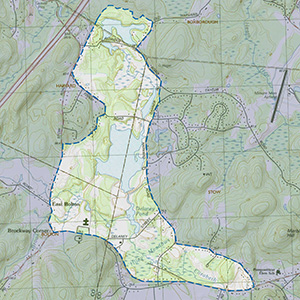Important Bird Area Sites in Massachusetts
Important Bird Area: Delaney Wildlife Management Area
Site Summary
Nominated By
Mark Lynch, Lisa and Simon Hennin
Size
580 acres
Towns and Counties
Bolton, Harvard, Stow; Worcester, Middlesex
Ownership
MassWildlife, private
Major Habitats
oak-conifer transitional forest, early successional shrubland, cultural grassland, emergent freshwater wetland, shrub-scrub wetland, lake/pond, river/stream
Land Use
hunting/fishing, other recreation or tourism, suburban/residential
IBA Criteria
- Category 1: Sites containing assemblages of species characteristic of a representative, rare, threatened, or unique habitat within the state or region.
- Category 2: Waterfowl: The site regularly supports 500 or more waterfowl at any one time. The designation "waterfowl" includes birds such as loons, grebes, cormorants, geese, ducks, coots, and moorhens.
- Category 4: Sites regularly holding significant numbers of species of high conservation priority in Massachusetts.
Site Description
This IBA is composed of wildlife management area (WMA) and the surrounding wetlands that form part of the upper Assabet River drainage along Elizabeth Brook. The area is part of a flood-control scheme. A medium-sized pond (Delaney Pond), with a dam at its southern shore has local areas of emergent vegetation along the edges and is popular with fishermen and hunters. The northern impoundment, less visited and less accessible to casual visitors, consists of several large sections of cattail marsh and another smaller pond (not part of the WMA) along the river. The surrounding woodland is mixed and is atop several eskers. There are several good stands of hemlock and areas of bog, but forests are predominantly mixed White Pine and deciduous trees with a fern understory. At the southern end, there is a small area of grassland where the Grasshopper and Savannah sparrows breed. The southern end is mostly old farmland in various stages of succession with scrubby and grassy fields bordered by stands of trees.
Current Conservation Status
The grassland at the dam where the Grasshopper Sparrows have bred is enormously popular with dog owners as a place to run their pets. Although Mass Wildlife has been notified of this problem, they have taken a hands-off approach. This problem could easily be rectified by fencing in several areas of grasses during the breeding season and signing the area. Other breeding species disturbed by dogs include Savannah Sparrows and Killdeer. A greater concern is the invasion of Purple Loosestrife in the formerly pure cattail areas. This is happening rapidly, especially in the north impoundment. It is these areas of cattail where the Least Bittern, King Rail, Common Moorhen, and Marsh Wren have been most often been recorded in the breeding season. Development around the edges of the Delaney property continues, and the outlaying areas of forest and marsh will be affected. This will lead to increased human presence in sensitive areas.
Ornithological Significance
This site is critical for an array of marsh birds and is a good site for spring migratory waterfowl as well. It represents one of the few areas of cattail marsh (away from Great Meadows) in the area. The site also has breeding Northern Goshawks and Grasshopper Sparrows.
Other Flora or Fauna of Significance
Migrating waterbirds: Common Goldeneye, Hooded Merganser, Bufflehead, Green-winged Teal.
Other breeding species: Green Heron, Wood Duck, Broad-winged Hawk, Winter Wren, Red-breasted Nuthatch, Pine Warbler, Canada Warbler, Savannah Sparrow (5-7 pairs), Swamp Sparrow, Killdeer.
The area is well known as a great place to find odonates and butterflies. A state significant population of the Silvery Blue exists here.
List provided by Gail Howe of Mass Audubon Broad Meadow Brook Wildlife Sanctuary
Data Sources
Data from extensive personal surveys during the breeding period. The area is still woefully under-recorded by visiting birders.




